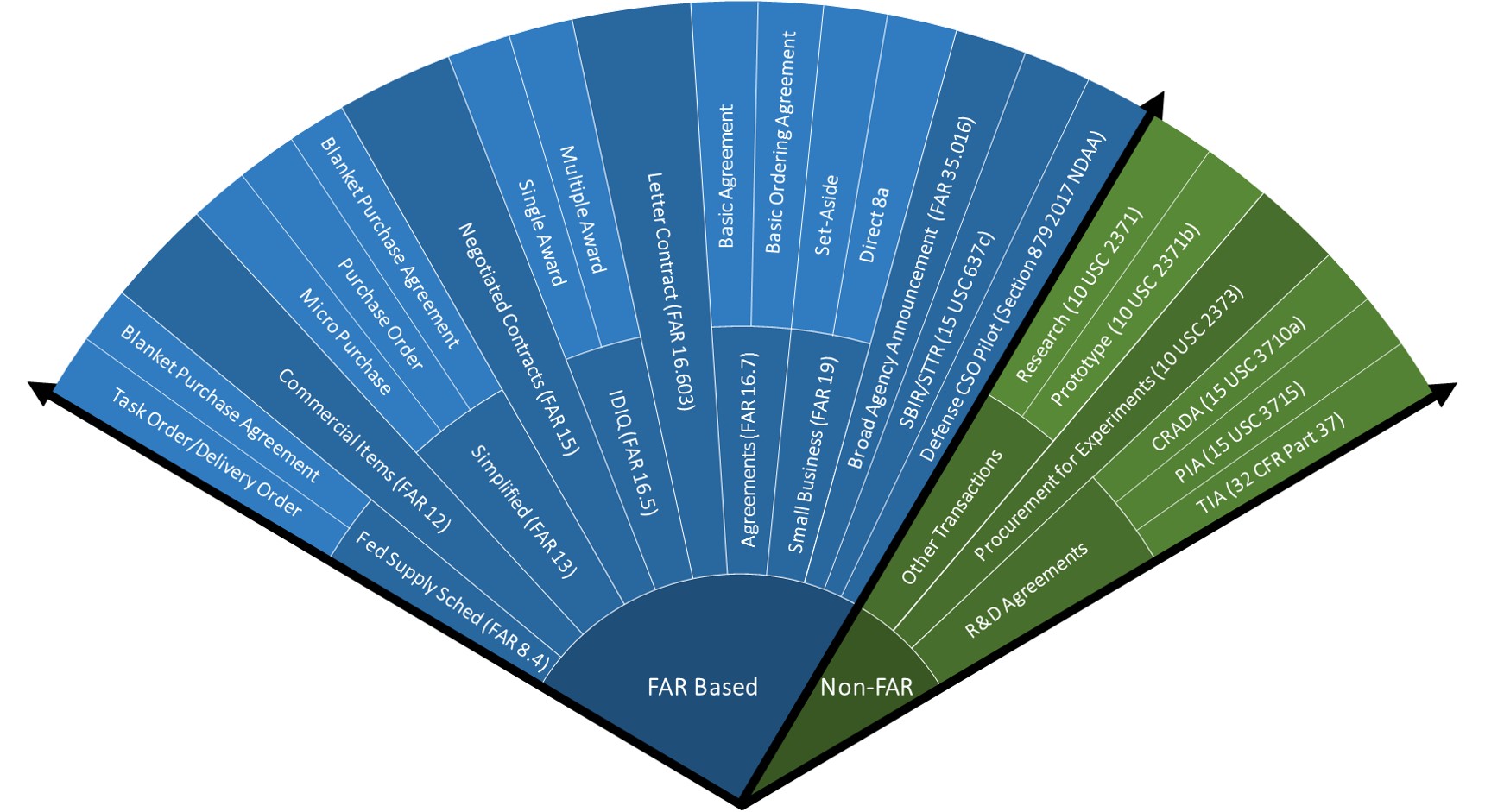Accelerate Contracting

Source: Section 809 Panel Volume III Report
Contracting is often one of the longest lead-items in the acquisition life-cycle, and also one of the riskiest. The time it takes to develop, solicit, and award a contract can inhibit the government’s ability to keep pace with the rapid changes in technology advancement.
Discovering avenues to speed the contracting process, while also preserving the inherent values of the federal contracting process is essential.
Government contracting is considered an art, and not a science. Federal contracting is often characterized as a rigid process that is burdened by an overwhelming amount of guidance, policy, and statute; however, it is also considered by many to be flexible, and embracing of creativity and innovation.
When it comes to finding the right contracting approach, it is important to understand that there are numerous contracting strategies, tools, and methods available. There is no single “right” way to contract, and that there are several available paths to achieve the desired outcome. It is important to bear in mind that each organization should have a “diversified” contracting approach – just like we are advised to diversify our personal investments, organizations should do the same for their contracting strategy. Often a program or Agency wants to seek the “path of least resistance” or “crack the code” with contracting, only to continue to exploit that contract strategy over and over again. While this may solve short-term or temporary needs, it is not a long-term sustainable strategy, and an organization is best positioned for repeatable success if it can diversify its contracting mechanisms to enable continuous speed, agility, and innovation.
Guiding Principles
- Contracting should be planned as part of a holistic business strategy for the organization
- Leverage existing contracts before developing new ones
- Engage contracting early and develop mutual objectives
- Both the Government and Contractors must be incentivized for speed
USD(A&S), in partnership with MITRE, developed the Contracting Cone to provide the full spectrum of available FAR and Non-FAR contract strategies. The supporting materials provide details about each contracting strategy, to enable collaborative discussions to select the right strategy based on environment, constraints, and desired outcomes.
Embedding Program Office Representatives for Better Communication
Temporarily embedding Government personnel with the Contractor can ease both parties through a mutual understanding of the requirements.
Breaking Apart Urgent Acquisitions
Get started on nebulous urgent acquisitions by breaking out the part you know and working on the next part concurrently
2 Ways to Justify Rates for Unaudited Small Businesses
Determining “fair and reasonable” is a judgment call but it may be hard to justify rates when the vendor is a start-up or unaudited small business.
3 Tips for Speeding Up Single Award IDIQs
Single Award Indefinite Delivery Indefinite Quantity (IDIQ) contracts and the orders under them can be awarded faster using these three best practices: pricing, quantity discounts, and blanket documentation.
Explore the Full Range of Contract Strategies
Explore the full range of FAR and Non-FAR contract strategies to meet your program needs.
Rapid Innovation Fund Strategies for Follow-ons
RIF follow-ons help firms cross the Acquisition valley of death. Other Transactions for Prototype and SBIR III’s are two easy strategies for reducing procurement lead time.
Price-Based Acquisition for When You Have More Data than Time
Streamline your next lot buy or your post-Other Transaction for Prototype production contract by using data you already have.
J&A Tricks for Flexible, Quick-Turn Contracts
J&A docs for sole source contracts can be a major schedule driver. By using class J&A’s and raising the ceiling to the nearest threshold, you can create contracts that are faster and more flexible for future quick-turn requirements.
Adding Out-of-Scope Work to Existing Contracts
Speed up contract awards by adding out-of-scope work to existing contracts via a J&A, but know the downside first and how to do it legally.
Program Managers: How to Get Your Contracting Officer to Care
Program managers can better bring their Contracting teams on board by showing them two things: the need and the threat, up close and personal.
Go Beyond the FAR with an OT
A flexible business arrangement with a non-traditional supplier to quickly develop a prototype system with significantly less administrative overhead.
Speeding with the FAR
Excerpts of the FAR that foster greater innovation, speed, and effectiveness in federal contracting.
Challenge Industry to Demonstrate Solutions
Challenges offer a promising alternative to the traditional acquisition and contracting approaches by enabling companies to demonstrate prototypes or systems that meet government requirements.
Make a Broad Agency Announcement
A notice from the government that requests scientific or research proposals from private firms and/or educational institutions concerning innovative ideas.
REFERENCES
- Contracting director shares plan for acquisition culture change, Jun 2019
- Engaging with Industry, DEPSECDEF Patrick Shanahan, Mar 2018
- Here’s How Ellen Lord Will Reduce Contracting Timelines by 50%, Aaron Mehta, Defense News
- Section 809 Panel Volume III Report – Section 7 on Simplifying Contracting, Jan 2019
- Challenge Based Acquisition Guide – The MITRE Corporation, Jan 2019 (4th Edition)
- Acquisition in the Digital Age (AiDA) Contracting References – The MITRE Corporation
- Other Transactions (OT) Guide, USD(A&S), Dec 2018
- DIUx Commercial Solutions Opening How-to Guide – Nov 2016
- Air Force Research Laboratory Broad Agency Announcement Guide for Industry – Mar 2015
- Going the Distance: Benefits of Competition Throughout the Life of a Program, Defense AT&L Magazine

